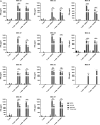Preclinical Assessment of CAR T-Cell Therapy Targeting the Tumor Antigen 5T4 in Ovarian Cancer
- PMID: 29239915
- PMCID: PMC5895166
- DOI: 10.1097/CJI.0000000000000203
Preclinical Assessment of CAR T-Cell Therapy Targeting the Tumor Antigen 5T4 in Ovarian Cancer
Abstract
Chimeric antigen receptor (CAR) T cells represent a novel targeted approach to overcome both quantitative and qualitative shortfalls of the host immune system relating to the detection and subsequent destruction of tumors. The identification of antigens expressed specifically on the surface of tumor cells is a critical first step in the ability to utilize CAR T cells for the treatment of cancer. The 5T4 is a tumor-associated antigen which is expressed on the cell surface of most solid tumors including ovarian cancer. Matched blood and tumor samples were collected from 12 patients with ovarian cancer; all tumors were positive for 5T4 expression by immunohistochemistry. Patient T cells were effectively transduced with 2 different anti-5T4 CAR constructs which differed in their affinity for the target antigen. Co-culture of CAR T cells with matched autologous tumor disaggregates resulted in antigen-specific secretion of IFN-gamma. Furthermore, assessment of the efficacy of anti-5T4 CAR T cells in a mouse model resulted in therapeutic benefit against established ovarian tumors. These results demonstrate proof of principle that 5T4 is an attractive target for immune intervention in ovarian cancer and that patient T cells engineered to express a 5T4-specific CAR can recognize and respond physiologically to autologous tumor cells.
Figures






References
MeSH terms
Substances
LinkOut - more resources
Full Text Sources
Other Literature Sources
Medical
Molecular Biology Databases

